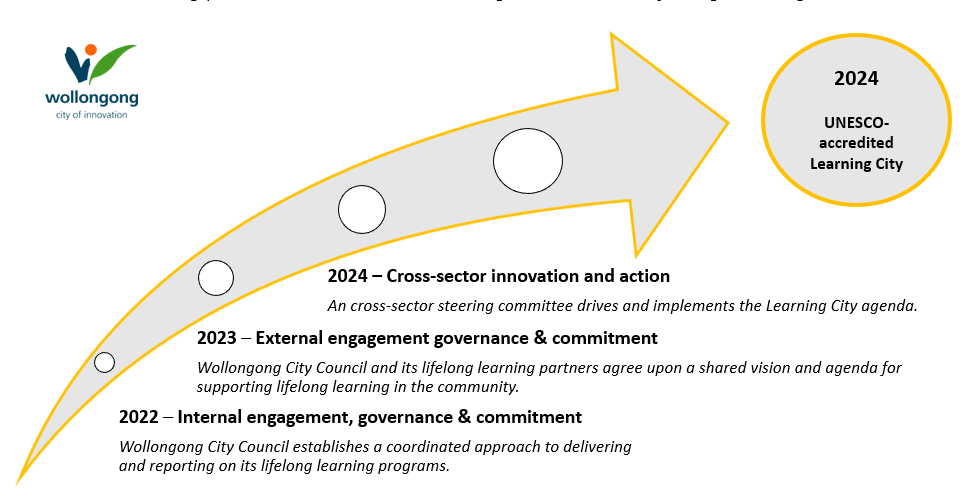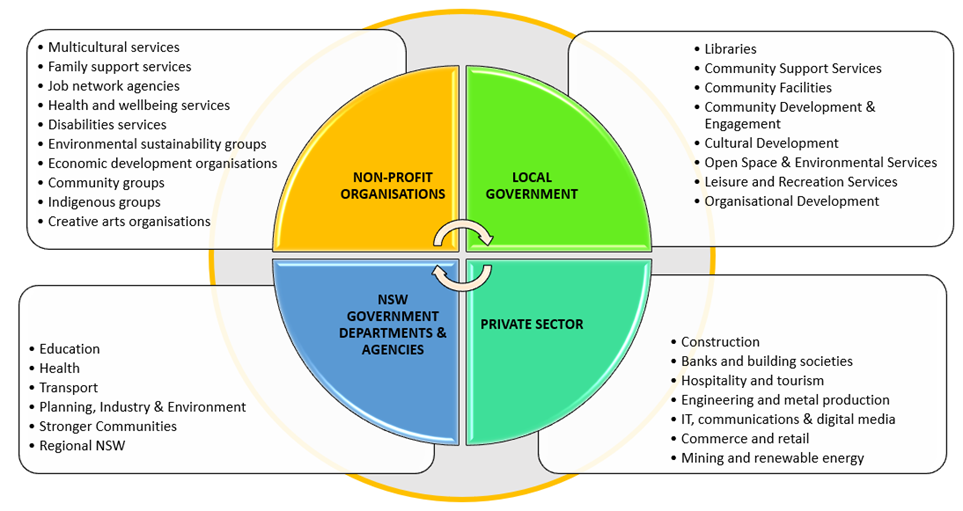Wollongong
The City of Wollongong is a Local Government Area (LGA) in the Illawarra region about 80km south of Sydney. Wollongong is the third-largest city in New South Wales and is bordered by an escarpment to the west, the ocean to the east and Lake Illawarra to the south. Wollongong was originally inhabited by the Dharawal people and today is home to nearly a quarter of a million people.
According to the data in Our Wollongong 2028 Community Strategic Plan:
- There were 5,346 people who identified as Aboriginal or Torres Strait Islander, representing 2.6% of the total population.
- 20% were born overseas in countries like the UK, China, Former Yugoslav Republic of Macedonia, Italy and New Zealand.
- 78% of the population only spoke English at home.
- The median age of the population was approximately 39 years and the city’s population is ageing with consistent growth in the proportion of people aged 50 years and over.
- 21.3% of households earned a high household income ($ 2,555 per week or more) and 29.0% of households earned a low income ($0 to $750 per week).
- A total of 76.6% of Wollongong’s households had broadband internet connection up from 71% in 2011. This varies across suburbs from a low of 55 to a high of 88.4%.
In addition, according to the 2016 Census QuickStats:
- Of people aged 15 and over, 13.1% reported having completed Year 12 as their highest level of educational attainment, 19.3% had completed a Certificate III or IV, 8.8% had completed an Advanced Diploma or Diploma and 17.4% had completed a Bachelor Degree level and above.
- Of the employed people in Wollongong, 4.3% worked in Hospitals (except Psychiatric Hospitals), 2.7% in Aged Care Residential Services, 2.7% in Higher Education, 2.5% in Supermarket and Grocery Stores and 2.5% in Iron Smelting and Steel Manufacturing.
The Our Wollongong 2028 Discussion Paper identified ten key issues and challenges facing Wollongong over the next ten years including the economy, population growth and climate change; in response to the discussion paper, the community identified similar challenges like financial sustainability, population growth and management, and environment, climate change, waste management and renewable energy.
Formal and Non-formal Learning Infra-structure
Wollongong LGA boasts a broad array of formal and informal learning infrastructure.
- Formal education is available through numerous preschools, public and private schools, the University of Wollongong, Wollongong TAFE and a range of Registered Training Organisations.
- Wollongong City Council delivers a range of community-based learning programs:
- Wollongong City Libraries offers a broad range of lifelong learning programs such as Baby Bookworms, Toddler Time, Lego Club, book clubs and Knit, Stitch and Yarn.
- Wollongong Art Gallery and Wollongong Botanic Gardens offer a range of learning programs and resources to schools and the public.
- Wollongong City Council’s Recreation Services, Memorial Gardens, Cultural Development, Organisational Development and Community Engagement teams offer a range of lifelong learning programs, resources and events to residents of Wollongong.
- There are also number not-for-profit/charitable organisations and social enterprises in the Wollongong LGA who utilise learning to support the community:
- SCARF provides learning programs that support newly arrived refugees to settle into life in Australia such as the L2P Driving Mentoring Program and Homework Help.
- The Multicultural Communities Council of Illawarra offers a range of learning resources and programs for Wollongong’s multicultural community such as water safety, cooking and a leadership program for young women.
- Beyond Empathy is a grassroots organisation that uses community, arts and cultural development (CACD) practice to support people living in areas of disadvantage.
As of July 2021, the full breadth of learning assets in the Wollongong LGA is unknown. A comprehensive mapping project will be completed by the middle of 2022.
Learning City Developments
Our Wollongong 2028 strategic plan pledges a commitment to this community vision: “From the mountains to the sea, we value and protect our natural environment and we will be leaders in building an educated, creative and connected community” (Page 7). Wollongong City Libraries (WCL) plays a core role in delivering on this promise: the Wollongong City Libraries Strategy 2017-2022 – Your library, your place sets out a clear vision to inspire reading, lifelong learning, creativity and inclusion in the community, deliverables of which include “develop and deliver training and educational programs to meet diverse community needs” (p.15); as such WCL is driving a Council-wide project to establish Wollongong as a UNESCO-accredited Learning City by 2024.
 Figure 1 Three-year plan for Wollongong's Learning City Project
Figure 1 Three-year plan for Wollongong's Learning City Project
(click to enlarge)
This three-year initiative to establish Wollongong as a Learning City is made up of three phases (Figure 1): phase 1 focuses mainly on internal engagement to establish a more coordinated approach to delivering, evaluating and reporting on Wollongong City Council’s community-based lifelong learning programs and events; phase 2 will involve community engagement and the establishment of a Learning City Steering Committee; phase 3 will see the creation of a Learning City Charter and/or Agenda and the launch of cross-sector initiatives.
In Australia, learning is being used as a driver for change in communities through active partnerships between local government, business and the community. Wollongong City Libraries envisages a learning city that connects parts to create whole by bringing together local government, non-profits, state government agencies and the private sector to achieve common goals through lifelong learning (Figure 2). WCL foresees the establishment of a steering committee with balanced representation from these sectors will be the key to a successful learning city.
Key Activities in the LC field
The Wollongong Learning City Project is addressing the three fundamental conditions for building a learning city, as per the Framework of the Key Features of Learning Cities in the UNESCO Guiding Documents. At present, this involves establishing the governance with lifelong learning stakeholders across Wollongong City Council to map existing resources, identify gaps and develop a draft action plan. It is understood that Wollongong City Council needs to lay the groundwork internally before going out to the community.
Phase 1 (2021-22) of the Learning City Project involves the following activities:
- A project working group and a project control group are established to:
- Initiate an internal lifelong learning community of practice;
- Map Council’s lifelong learning assets (programs, tools and practices) and lifelong learning partners;
- Identify gaps in our offerings and opportunities for collaboration and mobilisation of existing resources;
- Develop a coordinated approach to evaluating and reporting on learning;
- Support the development of a ‘collective impact’ community engagement plan;
- Develop a Learning City Action Plan.
- Wollongong City Council participates in the 2021 Global Learning Festival hosted by Wyndham and Melton City Councils, and conducts research on what it takes to host a successful learning festival.
- Wollongong City Council commits to establishing Wollongong as a Learning City.
- Wollongong City Libraries actively engages in communities of practice such as the Australian Learning Communities Network, the PASCAL Observatory Learning Cities Networks, and the Australian Library and Information Association.
Key Priority Areas for Future Development
Wollongong City Libraries is focused on establishing the fundamental conditions for a learning city between 2021 and 2024:
- Establish a coordinated approach to the delivery, evaluation and reporting on lifelong learning initiatives offered by Wollongong City Council; and gain internal commitment and a shared vision for the Learning City Project.
- Engage with the broader Wollongong community in a meaningful way to understand their learning needs and areas of interest and map existing learning resources.
- Establish a Learning City Steering Committee with balanced representation from all sectors to drive the Learning City Agenda in 2024 and beyond.
In the future, the Learning City Steering Committee may choose to prioritise the following areas of concern in the city:
- Environmental sustainability
- Aboriginal culture and engagement
- Access, diversity and inclusion in training and employment
- Economic development
- Health and wellbeing

 Figure 2 Wollongong's vision for a learning city: connecting parts
Figure 2 Wollongong's vision for a learning city: connecting parts
